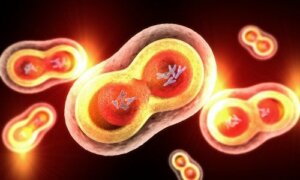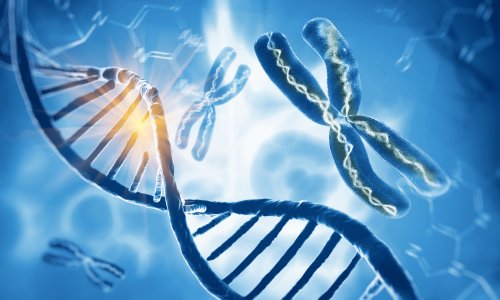How to Explain Mitosis to Children


Written and verified by the biologist Olga Carbajo
After fertilization, the cell of the newly formed embryo must give rise to all the others until a complete body is created. Once formed, it must grow and, during this process, the cells of its body mature, multiply, and die. But how do cells reproduce? In this article, we’ll see how to explain mitosis, the process of cell reproduction, to children.
What is mitosis?: Explanation for children
Mitosis is the process by which cells multiply. It’s one of the 2 stages that make up the cell cycle and takes place after the duplication of the genetic material. As a result, two daughter cells equal to the mother cell are obtained.
Mitosis takes place in somatic cells, i.e. any cell in the body that’s not a gamete. Gametes are formed by another process called meiosis, which isn’t a cell multiplication, but the opposite, a division.
The cells of our body resort to mitosis when we need to grow or repair a wound caused in a tissue, a bone, an organ. How does the process of mitosis take place?
The phases of mitosis explained for children
In order for cells to reproduce, a previous phase, Interphase, is necessary, during which the genetic material is duplicated and the cell goes from having 23 pairs of chromosomes to 46 pairs. In addition, some organelles, such as centrioles, are duplicated, while others disappear and then, in a matter of hours, are synthesized again.
Therefore, everything’s ready for the cell to enter mitosis. The process takes place in 4 clearly differentiated phases: Prophase, Metaphase, Anaphase, and Telophase.

Phase 1: Prophase
- The genetic material of the cells begins to condense and the chromosomes are visualized.
- The nuclear membrane destabilizes and disappears.
- The centrioles, one of the most important organelles for this process, duplicate and begin to travel towards the cell poles.
Phase 2: Metaphase
To better understand this phase, we must imagine the cell as a sphere similar to the Earth.
- At the poles, we will have centrioles, from which fibers that resemble the lines of latitude of the Earth will begin to grow. This structure is called the mitotic spindle.
- The chromosomes directed by the fibers of this spindle go to the equator of the cells, remaining there aligned to form the equatorial plate.
Phase 3: Anaphase
Once the chromosomes are aligned, the centrioles begin to collect the mitotic spindle fibers. This causes the chromosomes trapped in the fibers, and shaped like an 8-armed spider, to break in two and be pulled towards the poles. Now, each chromosome returns to having two chromatids, or in other words, 4 arms.
Phase 4: Telophase
Once the chromosomes have positioned themselves at the opposite poles of the cell, they begin to decondense. At the same time, the cell will again form the nuclear membrane around them from the aster fibers of the centrioles.
The final stage of the mitosis process explained for children: Cytokinesis
At this point, all that’s left is to physically divide the mother cell to give rise to the two daughter cells. Paradoxically, the process of cell multiplication, in the end, is a division, so that the mother cell disappears, converted into two daughter cells.
The resulting daughter cells will be genetically the same as the mother cell and will contain the same organelles as the mother cell. Although the function they carry out will depend on the genes that are expressed and the degree of maturation of the original cell.

What happens if mistakes are made during mitosis?
The errors that can occur during the process are very few, as the cell has a strict quality system and stops the production process if the error is fatal. This fact doesn’t detract from the fact that errors can occur, especially in the first divisions of the zygote. If such an error can’t be repaired and the cell cycle continues its course, the abnormality may turn out to be imperceptible or it can even be carcinogenic.
One of the most frequent errors is chromosome nondisjunction, where one of the homologous chromosomes doesn’t separate correctly during Anaphase. As a result, we obtain one daughter cell with three chromosomes, trisomy, and the other with only one, aneuploidy.
On other occasions, the chromosomes can be damaged, either by breakage of one of their arms, causing a deletion, or a fragment can be incorporated into a chromosome of another pair, causing a translocation. It may also be the case that the fragment is integrated in the opposite direction in the same chromosome, causing an inversion.
And finally, to explain mitosis to children…
To finish this article on how to explain mitosis to children, an interesting fact. The process was first described in 1848 by the German botanist Wilhelm Hofmeister, who was studying the embryonic development of superior plants. However, Walther Flemming is credited with the discovery, as he was the first to see the dividing chromosomes.
“Great discoveries and improvements invariably involve the cooperation of many minds.”
-Alexander Graham Bell-
After fertilization, the cell of the newly formed embryo must give rise to all the others until a complete body is created. Once formed, it must grow and, during this process, the cells of its body mature, multiply, and die. But how do cells reproduce? In this article, we’ll see how to explain mitosis, the process of cell reproduction, to children.
What is mitosis?: Explanation for children
Mitosis is the process by which cells multiply. It’s one of the 2 stages that make up the cell cycle and takes place after the duplication of the genetic material. As a result, two daughter cells equal to the mother cell are obtained.
Mitosis takes place in somatic cells, i.e. any cell in the body that’s not a gamete. Gametes are formed by another process called meiosis, which isn’t a cell multiplication, but the opposite, a division.
The cells of our body resort to mitosis when we need to grow or repair a wound caused in a tissue, a bone, an organ. How does the process of mitosis take place?
The phases of mitosis explained for children
In order for cells to reproduce, a previous phase, Interphase, is necessary, during which the genetic material is duplicated and the cell goes from having 23 pairs of chromosomes to 46 pairs. In addition, some organelles, such as centrioles, are duplicated, while others disappear and then, in a matter of hours, are synthesized again.
Therefore, everything’s ready for the cell to enter mitosis. The process takes place in 4 clearly differentiated phases: Prophase, Metaphase, Anaphase, and Telophase.

Phase 1: Prophase
- The genetic material of the cells begins to condense and the chromosomes are visualized.
- The nuclear membrane destabilizes and disappears.
- The centrioles, one of the most important organelles for this process, duplicate and begin to travel towards the cell poles.
Phase 2: Metaphase
To better understand this phase, we must imagine the cell as a sphere similar to the Earth.
- At the poles, we will have centrioles, from which fibers that resemble the lines of latitude of the Earth will begin to grow. This structure is called the mitotic spindle.
- The chromosomes directed by the fibers of this spindle go to the equator of the cells, remaining there aligned to form the equatorial plate.
Phase 3: Anaphase
Once the chromosomes are aligned, the centrioles begin to collect the mitotic spindle fibers. This causes the chromosomes trapped in the fibers, and shaped like an 8-armed spider, to break in two and be pulled towards the poles. Now, each chromosome returns to having two chromatids, or in other words, 4 arms.
Phase 4: Telophase
Once the chromosomes have positioned themselves at the opposite poles of the cell, they begin to decondense. At the same time, the cell will again form the nuclear membrane around them from the aster fibers of the centrioles.
The final stage of the mitosis process explained for children: Cytokinesis
At this point, all that’s left is to physically divide the mother cell to give rise to the two daughter cells. Paradoxically, the process of cell multiplication, in the end, is a division, so that the mother cell disappears, converted into two daughter cells.
The resulting daughter cells will be genetically the same as the mother cell and will contain the same organelles as the mother cell. Although the function they carry out will depend on the genes that are expressed and the degree of maturation of the original cell.

What happens if mistakes are made during mitosis?
The errors that can occur during the process are very few, as the cell has a strict quality system and stops the production process if the error is fatal. This fact doesn’t detract from the fact that errors can occur, especially in the first divisions of the zygote. If such an error can’t be repaired and the cell cycle continues its course, the abnormality may turn out to be imperceptible or it can even be carcinogenic.
One of the most frequent errors is chromosome nondisjunction, where one of the homologous chromosomes doesn’t separate correctly during Anaphase. As a result, we obtain one daughter cell with three chromosomes, trisomy, and the other with only one, aneuploidy.
On other occasions, the chromosomes can be damaged, either by breakage of one of their arms, causing a deletion, or a fragment can be incorporated into a chromosome of another pair, causing a translocation. It may also be the case that the fragment is integrated in the opposite direction in the same chromosome, causing an inversion.
And finally, to explain mitosis to children…
To finish this article on how to explain mitosis to children, an interesting fact. The process was first described in 1848 by the German botanist Wilhelm Hofmeister, who was studying the embryonic development of superior plants. However, Walther Flemming is credited with the discovery, as he was the first to see the dividing chromosomes.
“Great discoveries and improvements invariably involve the cooperation of many minds.”
-Alexander Graham Bell-
All cited sources were thoroughly reviewed by our team to ensure their quality, reliability, currency, and validity. The bibliography of this article was considered reliable and of academic or scientific accuracy.
- Pérez Porto, J. y Merino, M. (2012). Definición de mitosis [ artículo en web]. Recuperado de: www.definicion.de
- Biología Infantil (octubre 2010). Reproducción celular [artículo en blog]. Recuperado de: www.biologiainfantil.blospost.com
- Medline (última consulta mayo 2019 ). Enfermedades genéticas. Recuperado de: www.medline.gov
- e-ducativa (última consulta mayo de 2019). La mitosis.[artículo en web educativa]. Recuperado de: www.catedu.es
This text is provided for informational purposes only and does not replace consultation with a professional. If in doubt, consult your specialist.








